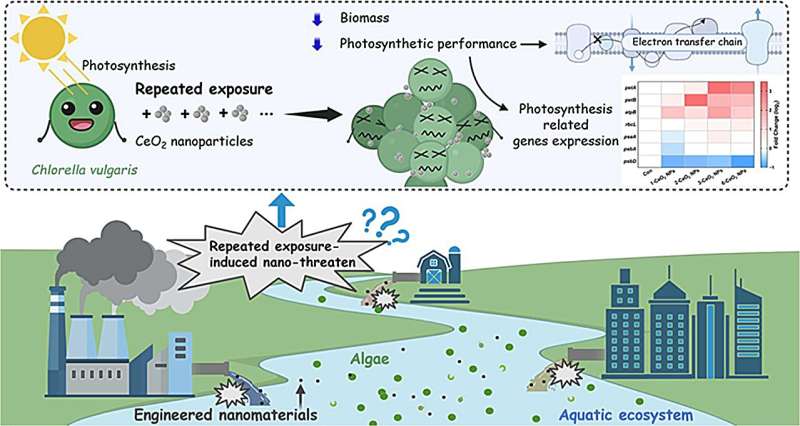This article has been reviewed according to Science X's editorial process and policies. Editors have highlighted the following attributes while ensuring the content's credibility:
fact-checked
proofread
CeO₂ nanoparticles: A double-edged sword for aquatic algal life

A new study reveals significant alterations in growth, photosynthetic activity, and gene expression of freshwater algae due to cerium oxide nanoparticles. This research highlights the complex interactions between these microscopic pollutants and key aquatic producers, providing essential insights into the ecological impacts of nanomaterial pollution.
As nanotechnology progresses, the pervasive use of cerium oxide nanoparticles in various industrial applications has led to their frequent dispersal into aquatic environments. These particles have become a routine element of industrial waste, interfacing with vital aquatic organisms like algae.
With increasing concerns over their effects on aquatic health and ecosystem stability, urgent and comprehensive research is needed to address the environmental threats posed by these nanoparticles.
The study, published in the journal Eco-Environment & Health, was conducted by a team from the State Key Laboratory of Biocontrol and the Guangdong Provincial Key Laboratory of Plant Resources at Sun Yat-sen University's Shenzhen Campus.
Considering that the exposure period of nanoparticles is deeply connected with the physiological rhythms of the exposed organisms, this research investigated the effects of CeO2 nanoparticles on Chlorella vulgaris in single and repeated sessions. Results indicate that repeated exposures markedly increase the algae's photosynthetic pigment content and oxidative stress levels, suggesting an intensified response to environmental stressors.
Additionally, these exposures decreased photosynthetic efficiency and reduced biomass, adversely affecting the alga's health and growth. Gene expression analysis showed a significant upregulation in photosynthesis-related genes, indicating an adaptive response to nanoparticle-induced stress. The findings underscore the complex effects of nanoparticles on aquatic life, highlighting the potential long-term ecological consequences of repeated nanoparticle exposures.
Professor Huang, the lead researcher on this project, states, "This study underscores the potential dangers of repeated nanoparticle exposure to algae, stressing the importance of evaluating nanomaterial risks in actual environmental settings. Our findings lay a scientific foundation for mitigating potential ecological risks associated with nanomaterials."
Understanding the impact of repeated CeO2 nanoparticle exposure on algal photosynthesis and growth is crucial for assessing the environmental risks posed by these materials. This knowledge can help in developing safer nanotechnology applications and inform environmental policy making, ensuring that the advancement of nanotechnologies aligns with environmental conservation goals.
More information: Saibo Liu et al, Repeated release of CeO2 nanoparticles altered algal responses: Growth, photosynthesis, and photosynthetic gene expression, Eco-Environment & Health (2024). DOI: 10.1016/j.eehl.2024.04.002
Provided by Sun Yat-sen University




















